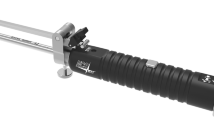Abstract
The purpose of the present study is to describe the technique of margin convergence for U-shaped rotator cuff tears and report the clinical outcomes and ultrasonography with a minimum of 2 years follow-up. Three hundred eleven patients with a rotator cuff tear were prospectively enrolled in a registry at one institution. Inclusion criteria included any patient undergoing arthroscopic margin convergence for a rotator cuff tear. Exclusion criteria included open or mini-open rotator cuff repairs or suture anchor fixation to the cuff insertion without margin convergence. The outcome measurements included physical examination, manual muscle testing, the American Shoulder and Elbow Surgeons (ASES) score, and ultrasonography. Nineteen patients met the study criteria and 13 were available for 2-year follow-up (68.4%). The mean age of this cohort was 62.2 ± 7.5 years with a mean pre-operative rotator cuff tear size of 4.0 ± 1.6 cm. The ASES score increased significantly from 50.0 ± 17.7 before surgery to 83.3 ± 19.5 at 2 years (P = 0.01). The active forward elevation also improved from 156.2 ± 11.9° before surgery to 168.0 ± 12.1 at 2 years (P = 0.03). The active external rotation 54.4 ± 14.5 at baseline and improved to 57.1 ± 19.1 at 2 years (P = 0.04). The strength also increased significantly from 6.7 ± 6.4 to 10.6 ± 4.9 lb at 1 year (P = 0.048). The post-operative ultrasound demonstrated that 46.2% of rotator cuff tears were healed at 2 years. In conclusion, margin convergence is a useful technique for U-shaped tears that are difficult to mobilize.




Similar content being viewed by others
References
Bretzke CA, Crass JR, Craig EV, Feinberg SB, Ultrasonography of the rotator cuff. Normal and pathologic anatomy. Invest Radiol. 1985;20:311–5.
Burkhart SS, Athanasiou KA, Wirth MA, Margin convergence: a method of reducing strain in massive rotator cuff tears. Arthroscopy. 1996;12:335–8.
Burkhart SS, Danaceau SM, Pearce CE, Arthroscopic rotator cuff repair: analysis of results by tear size and by repair technique-margin convergence versus direct tendon-to-bone repair. Arthroscopy. 2001;17:905–12.
Calvert PT, Packer NP, Stoker DJ, Bayley JI, Kessel L, Arthrography of the shoulder after operative repair of the torn rotator cuff. J Bone Joint Surg Br. 1986; 68:147–50.
Galatz LM, Ball CM, Teefey SA, Middleton WD, Yamaguchi K, The outcome and repair integrity of completely arthroscopically repaired large and massive rotator cuff tears. J Bone Joint Surg Am. 2004;86:219–24.
Gerber C, Fuchs B, Hodler J, The results of repair of massive tears of the rotator cuff. J Bone Joint Surg Am. 2000;82:505–15.
Goutallier D, Postel JM, Bernageau J, Lavau L, Voisin MC, Fatty muscle degeneration in cuff ruptures. Pre- and postoperative evaluation by CT scan. Clin Orthop Relat Res, 1994;304:78–83.
Harryman DT, Mack LA, Wang KY, Jackins SE, Richardson ML, Matsen FA, Repairs of the rotator cuff. Correlation of functional results with integrity of the cuff. J Bone Joint Surg Am. 1991; 73:982–9.
Hodler J, Fretz CJ, Terrier F, Gerber C, Rotator cuff tears: correlation of sonographic and surgical findings. Radiology. 1988;169:791–4.
Huijsmans PE, Pritchard MP, Berghs BM, van Rooyen KS, Wallace AL, de Beer JF, Arthroscopic rotator cuff repair with double-row fixation. J Bone Joint Surg Am. 2007;89:1248–57.
Klepps S, Biship J, Lin J, Cahlon O, Strauss A, Hayes P, Flatow EL, Prospective evaluation of the effect of rotator cuff integrity on the outcome of open rotator cuff repairs. Am J Sports Med. 2004;32:1716–22.
Liu SH, Baker CL, Arthroscopically assisted rotator cuff repair: correlation of functional results with integrity of the cuff. Arthroscopy. 1994;10:54–60.
Mack LA, Nyberg DA, Matsen FA, 3rd, Sonographic evaluation of the rotator cuff. Radiol Clin North Am. 1988;26:161–77.
Michener LA, McClure PW, Sennett BJ, American Shoulder and Elbow Surgeons Standardized Shoulder Assessment Form, patient self-report section: reliability, validity, and responsiveness. J Shoulder Elbow Surg, 2002;11:587–94.
Middleton WD, Reinus WR, Totty WG, Melson CL, Murphy WA, Ultrasonographic evaluation of the rotator cuff and biceps tendon. J Bone Joint Surg Am. 1986;68:440–50.
Nho, S, Shindle MK, Adler RS, Warren RF, Altchek DW, MacGillivray JD. Prospective analysis of arthroscopic rotator cuff repair: subgroup analysis. J Shoulder Elbow Surg. 2009;18:697–704.
Packer NP, Calvert PT, Bayley JI, Kessel L, Operative treatment of chronic ruptures of the rotator cuff of the shoulder. J Bone Joint Surg Br. 1983;65:171–5.
Thomazeau H, Boukobza E, Morcet N, Chaperon J, Langlais F, Prediction of rotator cuff repair results by magnetic resonance imaging. Clin Orthop Relat Res. 1997;344:275–83.
Wilson FV, Hinov V, Adams G, Arthroscopic repair of full-thickness tears of the rotator cuff: 2- to 14-year follow-up. Arthroscopy. 2002;18:136–44.
Author information
Authors and Affiliations
Corresponding author
Additional information
Each author certifies that he or she has no commercial associations (e.g., consultancies, stock ownership, equity interest, patent/licensing arrangements, etc.) that might pose a conflict of interest in connection with the submitted article.
Each author certifies that his or her institution has approved the reporting of this study, that all investigations were conducted in conformity with ethical principles of research.
Level of Evidence: Level IV: Case Series
Rights and permissions
About this article
Cite this article
Shindle, M.K., Nho, S.J., Nam, D. et al. Technique for Margin Convergence in Rotator Cuff Repair. HSS Jrnl 7, 208–212 (2011). https://doi.org/10.1007/s11420-011-9222-3
Received:
Accepted:
Published:
Issue Date:
DOI: https://doi.org/10.1007/s11420-011-9222-3




